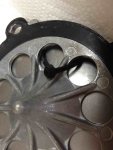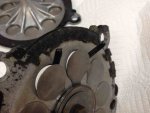90 HP 3 cylinder 2 stroke - suddenly running very rough, puffing air/fuel from lower carb
Was out skiing w/ the boat early this morning. Started right up, ran as normal (very well) for most of the session, but started stalling out at idle and when adding throttle from idle at the pull-up - seemed like a little water in the gas line or such. Would start back up, but needed some throttle and choke to do so. Also wasn't running as strongly as normal at skiing speed of 32-33mph toward the end. Went back out on the boat this afternoon, and from the start, it was running very rough, stalling out at idle, etc. Was having trouble getting it over 4k RPM, seemed almost to be running on just 2 cylinders. Boat was on the water, so not much diagnostic could be done, but I did confirm that all 3 plugs are sparking. Carb pushrods are all in place, and are all moving when throttle lever is moved. Pulled the air intake cover, and the lower-most cylinder is sort of chuffing/puffing out air/fuel while the engine is running at low RPM. (The top 2 are only sucking air in.) It seems to spit less at higher RPMs, but still runs like crud.
Engine also seemed to be running a bit hotter than normal (pee stream draining after shutting engine off was warmer than normal, and while I could put my hand on top of the block, it was more uncomfortable than normal. No heat alarm went off or such.
Have not had a chance to try a compression test yet.
Thoughts? Could this be a reed valve problem of some sort? (I'm no mechanic, but that's the only thing that I could think of in a 2-stroke engine that might lead to this type of behavior...)
I appreciate any/all input - would love to get the boat back in service soon!
Jim
Was out skiing w/ the boat early this morning. Started right up, ran as normal (very well) for most of the session, but started stalling out at idle and when adding throttle from idle at the pull-up - seemed like a little water in the gas line or such. Would start back up, but needed some throttle and choke to do so. Also wasn't running as strongly as normal at skiing speed of 32-33mph toward the end. Went back out on the boat this afternoon, and from the start, it was running very rough, stalling out at idle, etc. Was having trouble getting it over 4k RPM, seemed almost to be running on just 2 cylinders. Boat was on the water, so not much diagnostic could be done, but I did confirm that all 3 plugs are sparking. Carb pushrods are all in place, and are all moving when throttle lever is moved. Pulled the air intake cover, and the lower-most cylinder is sort of chuffing/puffing out air/fuel while the engine is running at low RPM. (The top 2 are only sucking air in.) It seems to spit less at higher RPMs, but still runs like crud.
Engine also seemed to be running a bit hotter than normal (pee stream draining after shutting engine off was warmer than normal, and while I could put my hand on top of the block, it was more uncomfortable than normal. No heat alarm went off or such.
Have not had a chance to try a compression test yet.
Thoughts? Could this be a reed valve problem of some sort? (I'm no mechanic, but that's the only thing that I could think of in a 2-stroke engine that might lead to this type of behavior...)
I appreciate any/all input - would love to get the boat back in service soon!
Jim
Last edited:





















